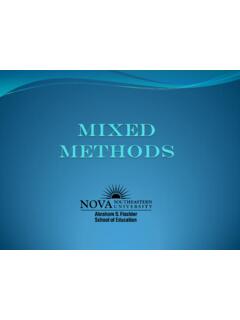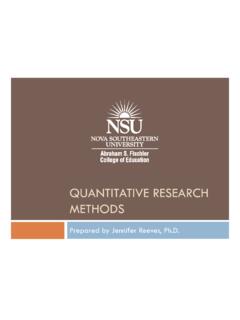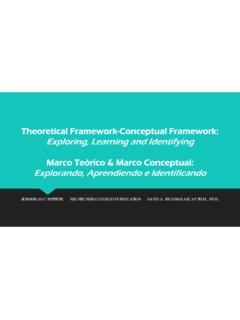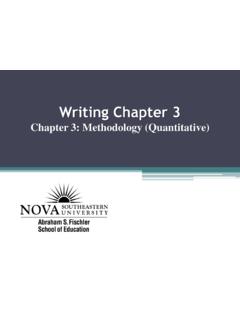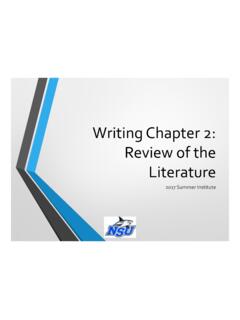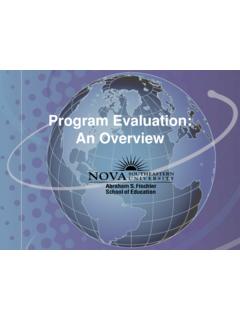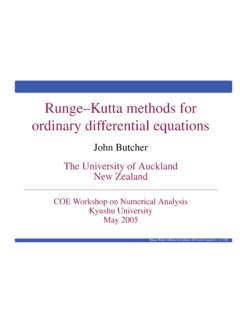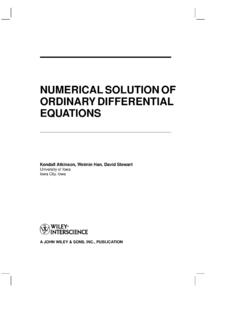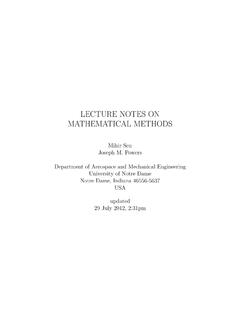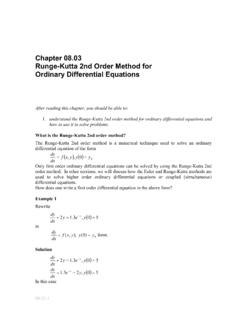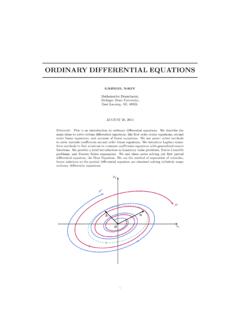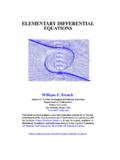Transcription of Writing Chapter 3 Chapter 3: Methodology
1 Participants Procedure Strategies of inquiry Data collection procedures Instruments Data analysis Limitations Concept Paper and Proposals Future Tense Final Report Past Tense Target populationand the samplethat you will use for generalizing about the target population. Demographic information such as age, gender, and ethnicity of your sample. Procedures for selecting the sample should be outlined, including justification for the sampling method, also known as sampling SamplingSelecting cases that are information-rich with respect to the purposes of the SamplingUse of findings from one case to inform the researcher s selection of the next in Sampling When not all participants agree to participate, then the research is left with volunteer participants biased sample Gain permission from Institutional Review Board (IRB) Gain permission from administrators at the research site Gatekeepers are individuals at the site who provide site access, help researcher locate people and identify places to study.
2 The gatekeeper may require written information about the , J. W. (2008).Educational research: Planning, conducting, and evaluating quantitative and qualitative research (3rd ed.).Upper Saddle River, NJ: Pearson Education. Qualitative studies are usually conducted at the research site. The researcher has personal contact with the participants through in-depth interviewing and prolonged observing. Qualitative studies are personal in nature and are not centered on variables or measures. Qualitative researchers use video cameras or audio recorders to record in-depth interviews for , J. W. (2008).Educational research: Planning, conducting, and evaluating quantitative and qualitative research (3rd ed.).Upper Saddle River, NJ: Pearson Education. Why the site was chosen What time and resources are required What will be accomplished at the site What potential there is for your presence to be disruptive What individuals at the site will gain from the study How you will use and report the results Creswell, J.
3 W. (2008).Educational research: Planning, conducting, and evaluating quantitative and qualitative research (3rd ed.).Upper Saddle River, NJ: Pearson Education. The Procedures section is based directly on the research questions. Specifically, this is the how-to section of the study and will introduce the designof the research and how the data will be collected based on the questions of interest. The material should be presented in a step-by-step fashion ( just like a recipe book). Another researcher should be able to replicate the study by reading the Procedures section without needing to ask any questions. Strategies of Inquiry Data Collection Data Recording InstrumentsQualitative Procedures:Components1. Identify the specific strategy of inquiry to be used 5 Qualitative Research Designs/ TraditionBIOGRAPHY/ORAL LIFE HISTORY understanding a person in their contextETHNOGRAPHY Primary qualitative research technique, need to understand others who are different from us at a collective level ethnic group, for example how do we understand and relate to others, need for research on why are some people different from other people, get to the bottom of differencesGROUNDED THEORY understanding causation of a belief or behaviorCASE STUDY in-depth understanding of a single case could be an individual PHENOMENOLOGY understanding a unique aspect of human phenomena2.
4 Provide some background information about the strategy Application of and brief definition for the discipline origin3. Discuss the Intended outcome from this type of strategy4. Discuss the source of this strategy5. Discuss why it is an appropriate strategy6. Identify how the use of this strategy will shape the type of questions asked, the form of data collection, the steps and data analysis, and the final narrative This section should include discussion about participants and the site The setting The actors (who will be interviewed) The events (what will the actors will be observed or interviewed doing) The process (the evolving nature of events undertaken by the actors within the setting) Indicate the type or types of data to be collected ( , observational, interviews, documents, audio and visual material). Interviews Individual Focus groups Participant observations Open-ended surveys Content analysisCreswell, J. W. (2008).
5 Educational research: Planning, conducting, and evaluating quantitative and qualitative research (3rd ed.).Upper Saddle River, NJ: Pearson Education. Types: One-on-one, phone, e-mail, focus group General open-ended questions are asked to allow the participant to create options for responding voice their experiences and perspectives Information is recorded, then transcribed for , J. W. (2008).Educational research: Planning, conducting, and evaluating quantitative and qualitative research (3rd ed.).Upper Saddle River, NJ: Pearson Education. Approachto DataCollectionType ofResponse Options toQuestionsTypes of InterviewsLeading toDataQuantitativeClosed-EndedStructured /Semi-StructuredInterviewsScores toAnswersQualitativeOpen-EndedUnstructur edInterviewsTranscriptionof WordsCreswell, J. W. (2008).Educational research: Planning, conducting, and evaluating quantitative and qualitative research (3rd ed.).Upper Saddle River, NJ: Pearson Education.
6 Developing Questions Mechanics of Question Development Piloting the Interview Questions Planning the Interview Recording the Interview A small-group interview Focus groups are useful when participants might be more willing to discuss the topic in front of peers ( , teen smokers views on smoking) Participants answers can inform others ( , participants can feed off one another, or group ideas might be generated that would not be available in one-one-one interviews) Time constraints or accessibility are issues for the researcher Traditional (or face-to-face) focus groups Online, synchronous focus groups Asynchronous focus groups Researcher acts as facilitator or moderator Level of moderation depends on participants Difficult to record and moderate; tape recording is generally necessary and a separate note taker (who is neither the researcher nor a participant) is recommended. Ethical considerations with regard to confidentialityGlesne, C.
7 (2006).Becoming qualitative researchers: An introduction (3rd ed.).Boston, MA: Pearson. Identify the interviewees. Determine the type of interview you will use ( , focus group, one-on-one). Obtain consent from the interviewee to participate in the study. Locate a quiet, suitable place for conducting the interview. During the interview, audiotape the questions and responses. Creswell, J. W. (2008).Educational research: Planning, conducting, and evaluating quantitative and qualitative research (3rd ed.).Upper Saddle River, NJ: Pearson Education. During the interview, have an interview plan using your interview protocol, but be flexible. Use probes to follow up on areas of interest. Include possible probes in your interview protocol. During the interview, design probes as you listen to what the participant is talking about. Be courteous and professional when the interview is , J. W. (2008).Educational research: Planning, conducting, and evaluating quantitative and qualitative research (3rd ed.)
8 Upper Saddle River, NJ: Pearson Education. Allow you as the researcher to immerse yourself into a social setting, enabling you to learn firsthand how the actions of participants are compatible with their words patterns of behaviors exist expected and unexpected experiences occur trust, relationships, and obligations with others are , C. (2006).Becoming qualitative researchers: An introduction (3rd ed.).Boston, MA: Pearson. Participant observation ranges across a continuum from mostly observing to mostly participating. Oftentimes the researcher finds his or herself at different points along the continuum during the data collection process (though this isn t necessary).Glesne, C. (2006).Becoming qualitative researchers: An introduction (3rd ed.). Boston, MA: Pearson. Nonparticipant ObserverObserver as ParticipantParticipant as ObserverFull Participant Obtain the required permissions needed to gain access to the site. Ease into the site slowly by looking around, getting a general sense of the site, and taking limited notes, at least initially.
9 Identify who or what to observe, when to observe, and how long to observe. Determine, initially, your role as an observer. Creswell, J. W. (2008).Educational research: Planning, conducting, and evaluating quantitative and qualitative research (3rd ed.).Upper Saddle River, NJ: Pearson Education. Conduct multiple observations over time to obtain the best understanding of the site and the individuals. Design some means for recording notes during an observation. Descriptive field notes describe the events, activities, and people. Reflective field notes record personal reflections that relate to insights, hunches, or broad themes that may emerge. When complete, slowly withdraw from the , J. W. (2008).Educational research: Planning, conducting, and evaluating quantitative and qualitative research (3rd ed.).Upper Saddle River, NJ: Pearson Education. Surveys with open-ended questions give participants the opportunity to express their opinions and give detailed answers.
10 They are different from closed-ended questions, which give you a set response choice. A combination of closed and open questions can be used ( , asking a closed-ended question, followed by an open-ended question, to allow the participant to explain his or her choice). Public and private records Good sources for text data Obtain permission before using documents Optically scan documents when possibleCreswell, J. W. (2008).Educational research: Planning, conducting, and evaluating quantitative and qualitative research (3rd ed.).Upper Saddle River, NJ: Pearson Education. Determine the material that can provide evidence to address your research questions. Determine if the material is available, and obtain permission to use it. Check the accuracy and authenticity of the material if you do not record it yourself. Collect the data and organize , J. W. (2008).Educational research: Planning, conducting, and evaluating quantitative and qualitative research (3rd ed.)
